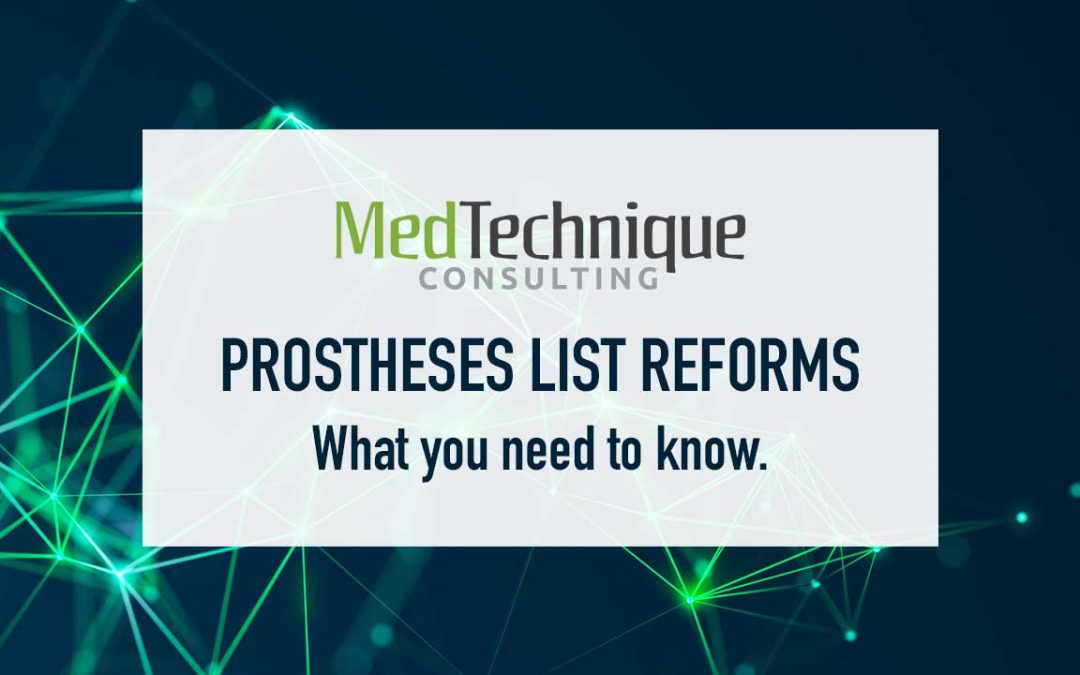In this article, our Director Sarah Griffin, highlights the recent changes to the Prostheses List, now known as the Prescribed List (PL), that came into effect on 11 September 2023, when a major part of Australian Government’s Prostheses List Reform agenda was implemented.
As manufacturers of medical devices accessing the Australian market, there have been significant changes to the Prostheses List, now known as the Prescribed List (PL). The reforms are now live with applicants required to navigate the Health Products Portal (HPP) with a significantly more onerous and complicated application process.
The Department of Health ran an information session In Sydney last week for applicants. Most were surprised to learn that the HHP for PL applications is currently only able to receive applications, but not yet able to assess them. It may be wise for applicants to expect a few hiccups in the assessment pathway. The deadline for applications this round is January 14, 2024.
There are three pathways for applications.
- Abbreviated,
- Clinical/Focussed Health Technology Assessment (HTA)
- Full HTA
Let’s now carefully examine each of the three pathways.
Pathway 1: Abbreviated
Most applications will go through the abbreviated pathway with assessment only by the Department of Health. There will be no clinical assessment. New products must be:
- Device is substantially equivalent to a listed device.
- Claiming non-inferiority
- TGA class IIb or lower
- No claims of novel features, characteristics, or functionality
or colloquially a ‘me-too’ product. Detailed information about the design, materials, specifications, adverse events and utilisation both here and overseas is required.
All TGA Class III devices must go through the second-tier pathway. The clinical pathway is similar to the current process where only comparative clinical effectiveness must be assessed, and the appropriate clinical group confirmed. Applications seeking a higher benefit, a new group, sub-group or suffix or which require clinical or economic questions to be addressed, will be assessed by a contracted HTA group.
Pathway 2: Clinical/Focussed Health Technology Assessment (HTA)
The second-tier pathway requires significantly more information than was previously supplied, and this information may not readily be available for some applicants. These include:
- Which health professional delivers service how are they trained to use the device and who pays for it?
- Is there a learning curve?
- Technical differences between devices and analysis of differences
- Utilisation and prices in other countries
- Projected utilisation over 5 years, and basis for projection
- Barriers and facilitators to uptake of new device in Australia
- Measures in place to restrict the use of the device to the intended population.
Pathway 3: Full HTA
The third pathway requires a full HTA conducted by the Medical Services Advisory Committee (MSAC). This pathway is required when:
- The new prosthesis employs a medical service that is not currently covered in the MBS. In this case it would be more efficient to apply directly to MSAC, rather than the PL.
- Or the new prosthesis potentially extends the range of indications/patients beyond the original intent of the MBS.
- OR the new prosthesis is novel/breakthrough/first-in-class.
- OR there is no suitable comparator on the PL.
- OR the new prosthesis has potential significant impact on PL or other system outlays.
- OR the clinical claim is improved quality of life and requires a modelled cost-utility analysis.
In summary, there have been significant changes in the funding of implantable devices through the Prostheses List Reforms, which include removal of ‘general use’ items such as staples, regrouping of all Prostheses List products, a new application process and platform and the introduction of cost recovery for applications.
The new application process, as with any process change, can be frustrating at times. There are elements in the online application process that are not intuitive and may take some time to navigate. Explanations as to the correct method are not always clear.
There is help available through:
- The email prostheses@health.gov.au.
- Technical support for the HPP can be accessed at HPP.Support@health.gov.au.
- There is no live support. Response times to both emails are quite random, and it may be several days before an answer is received.
If you need help with your Prostheses List Application in Australia and/or have any questions, you can contact us at MedTechnique Consulting to find out how we can help you with your application and to achieve market access in Australia at info@medtechnique.com.au.
At MedTechnique Consulting our experienced team have helped many organisations navigate the Australian healthcare landscape, gain market access and submit successful reimbursement applications.
About the Author
Sarah Griffin, Director of MedTechnique Consulting. Sarah is an experienced health economist, reimbursement strategist, health policy advocate and speaker.
Connect with Sarah Griffin on LinkedIn.
If you would like to learn more about Sarah’s speaking experience for your next event please email: Kim MacDonald, Spindrift Marketing




